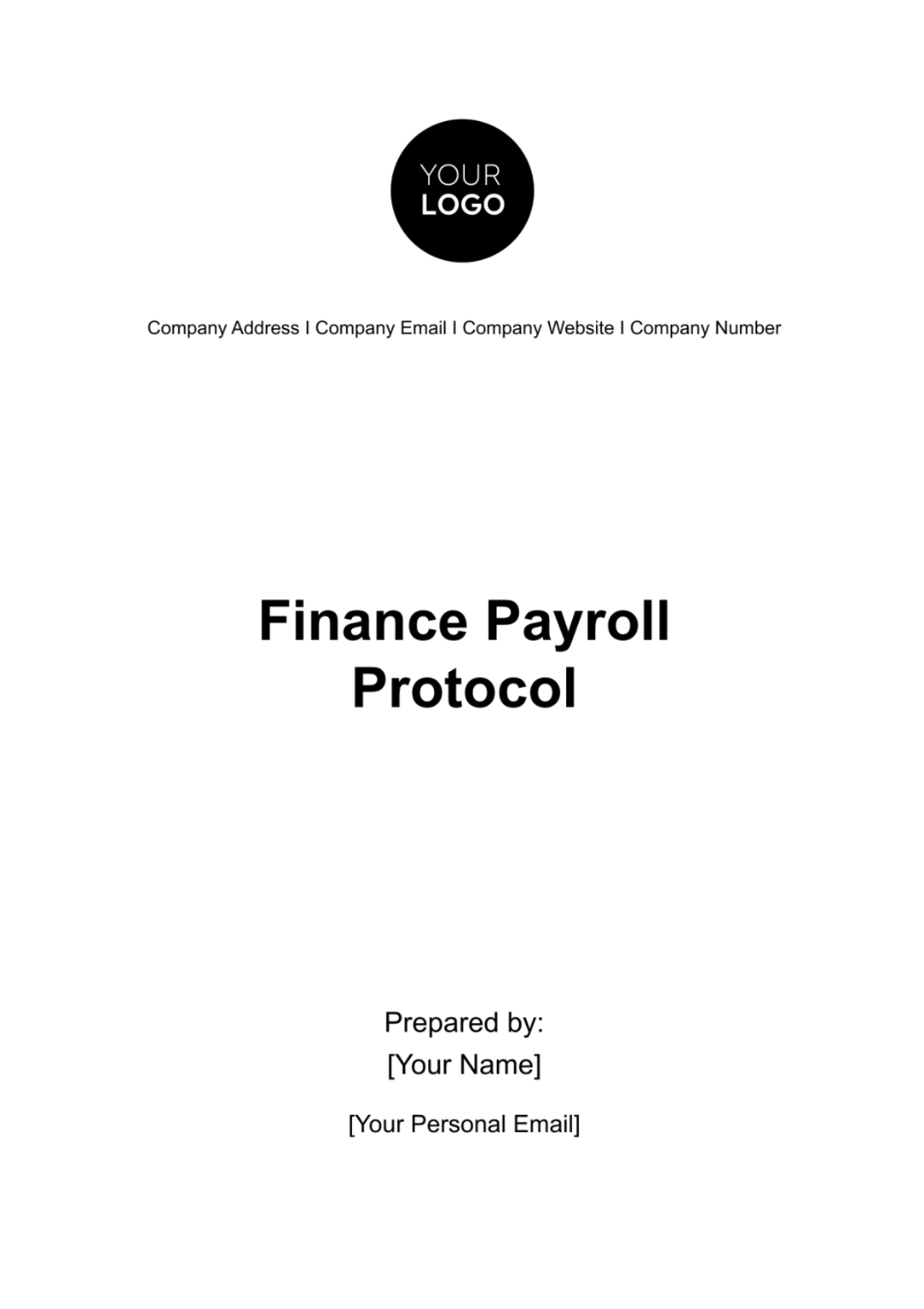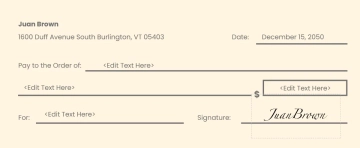Free Finance Payroll Protocol

I. Payroll Schedule and Deadlines
Payroll Calendar
At [Your Company Name], we operate on a structured bi-weekly payroll schedule. Each pay period concludes on alternate Fridays, ensuring a consistent and predictable payment rhythm for all employees. Payroll processing begins promptly the following Monday, allowing for a comprehensive review of all records and calculations. This regularity in the payroll schedule not only facilitates better financial planning for employees but also enhances the efficiency of our accounting practices, ensuring that all disbursements are timely and accurate.
Timesheet Submission Deadlines
To maintain this efficiency, it is imperative that all employees adhere to strict timesheet submission deadlines. Each staff member is required to submit their timesheet by the close of business on the last day of the pay period. Late submissions, while accommodated, will be processed in the subsequent payroll cycle. This policy ensures that payroll processing remains streamlined and minimizes delays or inaccuracies that could arise from late entries. It's a crucial part of maintaining the integrity and punctuality of our payroll system.
Adjustments and Exceptions
The payroll department recognizes that adjustments, such as overtime, bonuses, or necessary corrections, are sometimes needed. To accommodate these adjustments, we require that they be submitted and duly approved at least two days before the scheduled payroll processing date. This window allows our payroll team sufficient time to verify and incorporate any changes, ensuring that each payroll reflects the most current and accurate financial compensations. Strict adherence to this protocol ensures fairness and accuracy in employee compensation.
II. Employee Classification and Compensation
This section outlines [Your Company Name]'s employee classification and compensation structure. It details the categories of employment, the compensation benefits associated with each category, and the process for managing changes in compensation.
A. Employee Classification
Employees are classified into categories: Full-Time, Part-Time, and Contractor. Each classification adheres to distinct policies regarding benefits, tax withholdings, and overtime.
Category | Description | Benefits Eligibility | Tax Withholding | Overtime Policy |
Full-Time | Employees working 40 hours per week. | Eligible for a full benefits package, including health insurance, retirement plans. | Standard withholding rates apply. | Eligible for overtime pay beyond 40 hours per week as per FLSA. |
Part-Time | Employees working less than 40 hours. | Eligible for prorated benefits based on hours worked. | Withholding based on earnings. | Eligible for overtime as per state regulations. |
Contractor | Independent contractors on project basis. | Not eligible for company benefits. | Responsible for own tax payments (1099-MISC). | Not applicable, paid based on contract terms. |
B. Compensation Structure
Salaries and wages are determined based on position and experience. Annual reviews are conducted for potential salary adjustments.
Position Level | Experience | Base Salary Range | Bonus Potential | Additional Notes |
Entry-Level | 0-2 years | $40,000 - $50,000 | Up to 5% of base salary | Eligible for standard company benefits. |
Mid-Level | 3-7 years | $60,000 - $80,000 | Up to 10% of base salary | Includes stock options after 1 year of service. |
Senior-Level | 8+ years | $90,000 - $120,000 | Up to 15% of base salary | Includes higher tier stock options and executive benefits. |
Management | Varies | $130,000 - $160,000 | Performance-based bonuses | Includes comprehensive executive benefits package. |
Executive | 10+ years | $170,000 and above | Performance-based bonuses, stock options | Tailored compensation packages based on role and experience. |
C. Changes in Compensation
Promotions or role changes involving compensation adjustments require approval from the HR and Finance departments and must be processed before the payroll cut-off date.
Type of Change | Example | Approval Required | Processing Timeframe |
Salary Increase | Annual merit raise based on performance. | HR and direct supervisor. | Processed in the next payroll cycle post-approval. |
Moving from Mid-Level to Senior-Level. | HR and Finance departments. | Must be processed before the payroll cut-off date following the promotion. | |
Role Change | Transition from Part-Time to Full-Time. | HR department. | Implemented in the payroll cycle immediately following the change. |
Bonus Allocation | Year-end performance bonus. | Finance department. | Distributed in the final payroll cycle of the fiscal year. |
Contractual Adjustment | Changes in contractor rates. | Contract manager and Finance department. | Applied from the start date of the revised contract. |
III. Payroll Processing and Verification
Here, we provide a structured approach to payroll processing and verification to ensure [Your Company Name] maintains high standards of accuracy and compliance in its payroll operations. Regular reviews and the prompt addressing of discrepancies reflect our commitment to fairness and transparency in employee compensation.
A. Processing Steps
Payroll is processed through [Payroll Software Name]. The process includes verifying timesheet data, calculating pay based on employee classification, and applying necessary deductions.
Step | Description | Sample Process |
Timesheet Data Collection | Gathering and inputting timesheet data into [Payroll Software Name]. | Employees submit timesheets electronically by the end of the pay period. |
Pay Calculation | Calculating pay based on employee classification and hours worked. | Full-time salaries are processed as per contract terms, while part-time and overtime hours are calculated based on submitted timesheets. |
Deductions Application | Applying necessary deductions like taxes, insurance, and retirement contributions. | Federal and state taxes are calculated and withheld as per legal requirements, along with deductions for benefits as opted by the employee. |
Payroll Approval | The initial payroll run is reviewed and approved by the payroll manager. | Preliminary payroll reports are generated for review, ensuring accuracy before final processing. |
Disbursement | Finalizing and disbursing salaries to employee accounts. | Payments are disbursed through direct bank transfers on the designated payday. |
B. Verification Process
Each payroll is subject to a verification check by the payroll manager to ensure accuracy. Discrepancies are flagged for immediate correction.
Verification Method | Description | Sample Discrepancy Addressed |
Cross-Checking Timesheets | Comparing submitted timesheets with logged hours in the system. | Discrepancies in reported hours versus logged hours are rectified. |
Pay Rate Verification | Ensuring the correct pay rates are applied to each employee. | Adjustments made for any discrepancies in hourly rates or salary figures. |
Deductions Accuracy Check | Reviewing the accuracy of all deductions applied. | Correction of any errors in tax calculations or benefit deductions. |
Final Payroll Review | Comprehensive review of the entire payroll before approval. | Ensures overall accuracy and completeness of the payroll. |
Post-Disbursement Audit | Conducting random audits after payroll disbursement for quality control. | Random checks to validate the accuracy of the disbursed payroll. |
IV. Tax Withholding and Compliance
In this crucial section, [Your Company Name]'s adherence to tax withholding guidelines and labor law compliance is outlined. The section also covers the distribution of year-end tax documents, emphasizing our commitment to legal compliance and accuracy in all aspects of payroll tax and labor regulations.
A. Tax Withholding Guidelines
[Your Company Name] diligently follows all federal and state tax withholding guidelines to ensure accurate and lawful deductions from employee wages. Each employee is required to submit a W-4 form upon hiring, with annual updates encouraged to reflect any significant financial changes, such as marital status or dependents. This practice ensures that withholding amounts are precise, thereby avoiding underpayment or overpayment of taxes. Additionally, the payroll team keeps abreast of changes in tax laws to adjust withholding rates accordingly, ensuring compliance and preventing any tax-related issues for both the company and the employees.
B. Compliance with Labor Laws
Our payroll operations strictly adhere to the Fair Labor Standards Act (FLSA) and relevant state-specific labor laws. This adherence includes meticulous compliance with overtime payment regulations, ensuring that employees are compensated at the correct overtime rates for hours worked beyond the standard 40-hour workweek. Additionally, we ensure that all wages meet or exceed the federal and state minimum wage requirements. Regular training sessions for payroll staff are conducted to stay updated on any amendments in labor laws, ensuring ongoing compliance and safeguarding the company against potential legal disputes related to payroll.
C. Year-End Tax Documents
Annually, [Your Company Name] undertakes the critical task of preparing and distributing year-end tax documents. W-2 forms are provided to all full-time and part-time employees, while 1099 forms are issued to contractors, detailing their earnings for the year. These documents are meticulously reviewed for accuracy and are distributed by January 31st, in compliance with IRS deadlines. This punctual and precise distribution of tax documents not only fulfills our legal obligations but also assists our employees and contractors in their personal tax preparations, demonstrating our commitment to supporting their financial wellbeing.
V. Record Keeping and Data Security
This final section details [Your Company Name]'s stringent policies and practices regarding payroll record maintenance, data security protocols, and documentation retention. Our approach is geared towards ensuring the highest levels of confidentiality, security, and compliance in managing sensitive payroll information.
A. Payroll Record Maintenance
At [Your Company Name], we maintain comprehensive payroll records for a minimum of seven years, a duration that exceeds the regulatory requirements. This extensive archive includes detailed timesheets, pay stubs, and all tax-related documents. This meticulous record-keeping practice is essential not only for compliance with tax and labor laws but also for internal audits and historical data analysis. By maintaining these records, we can swiftly address any inquiries or audits from regulatory bodies and provide valuable data for financial and strategic planning.
B. Data Security Protocols
Understanding the sensitivity of payroll data, we implement robust data security protocols. All payroll information is encrypted using advanced cybersecurity measures to prevent unauthorized access or data breaches. Access to this sensitive information is strictly limited to authorized personnel within the finance and HR departments, each bound by confidentiality agreements. Regular training in data protection is provided to these employees, ensuring they are aware of the latest security practices and protocols. This focus on data security protects not only our employees' personal information but also guards against potential cyber threats.
C. Documentation Retention
To further ensure the security and integrity of our payroll records, [Your Company Name] adopts a dual approach to documentation retention. Digital copies of all payroll-related documents are stored on secure servers with backup and recovery systems in place. Additionally, physical copies of critical documents are retained in a locked and secure facility, accessible only to authorized staff. This dual storage approach, complying with data protection and privacy laws, ensures that our payroll records are preserved, secure, and accessible when needed.
- 100% Customizable, free editor
- Access 1 Million+ Templates, photo’s & graphics
- Download or share as a template
- Click and replace photos, graphics, text, backgrounds
- Resize, crop, AI write & more
- Access advanced editor
Effortlessly manage your business finances with Template.net's editable Finance Payroll Protocol. This customizable template, easily editable in our Ai Editor Tool, simplifies payroll management. Experience streamlined financial operations, minimizing errors and maximizing productivity. Let our Finance Payroll Protocol enterprise solution drive your business to new heights. Trust Template.net for reliability and efficiency.





























